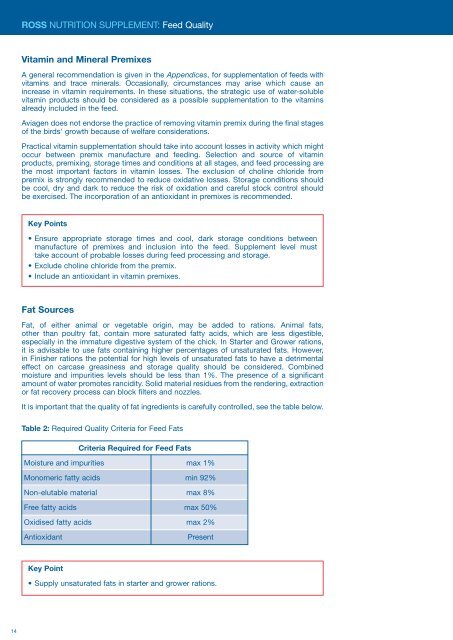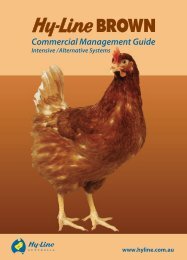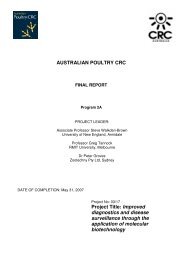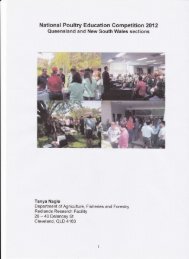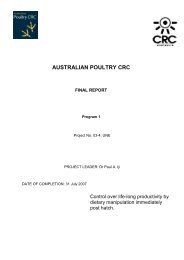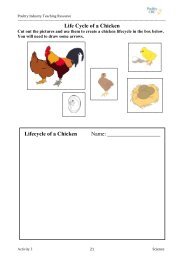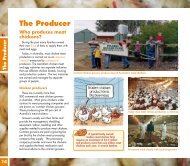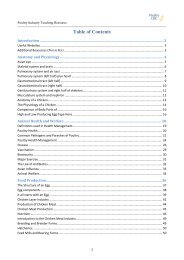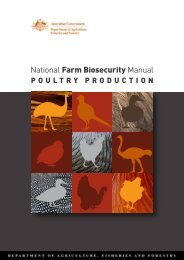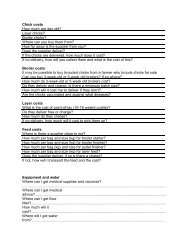Ross Broiler Nutrition Supplement - Poultry Hub
Ross Broiler Nutrition Supplement - Poultry Hub
Ross Broiler Nutrition Supplement - Poultry Hub
You also want an ePaper? Increase the reach of your titles
YUMPU automatically turns print PDFs into web optimized ePapers that Google loves.
ROSS NUTRITION SUPPLEMENT: Feed Quality<br />
Vitamin and Mineral Premixes<br />
A general recommendation is given in the Appendices, for supplementation of feeds with<br />
vitamins and trace minerals. Occasionally, circumstances may arise which cause an<br />
increase in vitamin requirements. In these situations, the strategic use of water-soluble<br />
vitamin products should be considered as a possible supplementation to the vitamins<br />
already included in the feed.<br />
Aviagen does not endorse the practice of removing vitamin premix during the final stages<br />
of the birds' growth because of welfare considerations.<br />
Practical vitamin supplementation should take into account losses in activity which might<br />
occur between premix manufacture and feeding. Selection and source of vitamin<br />
products, premixing, storage times and conditions at all stages, and feed processing are<br />
the most important factors in vitamin losses. The exclusion of choline chloride from<br />
premix is strongly recommended to reduce oxidative losses. Storage conditions should<br />
be cool, dry and dark to reduce the risk of oxidation and careful stock control should<br />
be exercised. The incorporation of an antioxidant in premixes is recommended.<br />
Key Points<br />
• Ensure appropriate storage times and cool, dark storage conditions between<br />
manufacture of premixes and inclusion into the feed. <strong>Supplement</strong> level must<br />
take account of probable losses during feed processing and storage.<br />
• Exclude choline chloride from the premix.<br />
• Include an antioxidant in vitamin premixes.<br />
Fat Sources<br />
Fat, of either animal or vegetable origin, may be added to rations. Animal fats,<br />
other than poultry fat, contain more saturated fatty acids, which are less digestible,<br />
especially in the immature digestive system of the chick. In Starter and Grower rations,<br />
it is advisable to use fats containing higher percentages of unsaturated fats. However,<br />
in Finisher rations the potential for high levels of unsaturated fats to have a detrimental<br />
effect on carcase greasiness and storage quality should be considered. Combined<br />
moisture and impurities levels should be less than 1%. The presence of a significant<br />
amount of water promotes rancidity. Solid material residues from the rendering, extraction<br />
or fat recovery process can block filters and nozzles.<br />
It is important that the quality of fat ingredients is carefully controlled, see the table below.<br />
Table 2: Required Quality Criteria for Feed Fats<br />
Criteria Required for Feed Fats<br />
Moisture and impurities max 1%<br />
Monomeric fatty acids min 92%<br />
Non-elutable material max 8%<br />
Free fatty acids max 50%<br />
Oxidised fatty acids max 2%<br />
Antioxidant<br />
Present<br />
Key Point<br />
• Supply unsaturated fats in starter and grower rations.<br />
14


